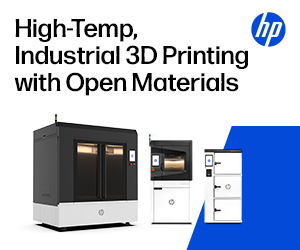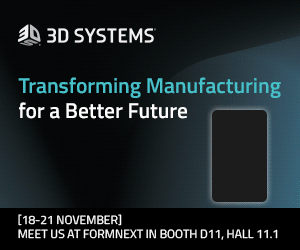 I’m a firm believer that technology can take us to unimaginable places, from both a physical and a mental standpoint. Technological progress is oftentimes charted along an exponential curve meaning that as time goes by the rate of progress increases exponentially instead of linearly. While it’s too still early to tell if 3D printing will fall into this category, we have already seen a tremendous amount of progress within the last few years alone–and if one quantum materials researcher, Jennifer Hoffman, has her way, we may be on the verge of an incredibly rapid advancement within the industry.
I’m a firm believer that technology can take us to unimaginable places, from both a physical and a mental standpoint. Technological progress is oftentimes charted along an exponential curve meaning that as time goes by the rate of progress increases exponentially instead of linearly. While it’s too still early to tell if 3D printing will fall into this category, we have already seen a tremendous amount of progress within the last few years alone–and if one quantum materials researcher, Jennifer Hoffman, has her way, we may be on the verge of an incredibly rapid advancement within the industry.
Hoffman, until now a professor of physics at Harvard University, will be joining the University of British Columbia (UBC) this month as the Canada Excellence Research Chair in quantum materials and devices based on oxide heterostructures. At her new position she will create a research program that will be focused on combining and creating new quantum materials with atomic precision. To take things a step further she is trying to create a method of 3D printing incredibly tiny objects, which can be measured only on an atomic scale.
Sound a bit insane or like something from Star Trek? Well it sort of is. For those unfamiliar with the world of quantum materials, these are materials which are not yet completely understood, even by some of the most advanced scientists. The everyday laws of classical physics cannot explain the almost spooky interactions found within such materials, which can possess incredibly useful magnetic and electronic properties.
![The Honourable Ed Fast and Jennifer Hoffman pictured Friday at UBC. [Image: UBC.ca]](https://3dprint.com/wp-content/uploads/2015/07/h3.jpg)
The Honourable Ed Fast and Jennifer Hoffman pictured Friday at UBC. [Image: UBC.ca]
So how exactly does she intend to 3D print objects at such an incredibly minute scale? She plans on combining two key processes, molecular beam epitaxy (MBE), which allows for the vertical stacking of individual atomic layers (this represents the Z-axis), with that of scanning probe lithography, which uses an extremely sharp tip to move and place individual atoms in a lateral direction (this represents the X- and Y-axes). Neither process is able to build 3D structures on  its own, but when combined 3D printing at the atomic level will be possible, according to Hoffman.
its own, but when combined 3D printing at the atomic level will be possible, according to Hoffman.
“We seek to embed arbitrary electronic structures into 3D materials with atomic-scale precision,” Hoffman explained in her proposal last year to the Gordon and Betty Moore Foundation. “One key 5-year focus is interface superconductivity, with two parallel goals of realizing higher Tc and topological superconductivity. In each case, we will establish a film growth recipe, perform detailed imaging to understand the materials, explore atom manipulation strategies, characterize superconducting behavior in confined geometries, and ultimately ‘print’ layered arrays of superconducting 0’s and 1’s to create quantum devices.”
Last year she submitted a CERC proposal on atomic scale 3D printing to the Canadian Government as well as a proposal to the Moore Foundation seeking grants for her research.
“Both of these proposals were funded, but I don’t have results to report yet,” explained Hoffman to 3DPrint.com. “This is a long-term, high-risk, high-reward research endeavor, so I don’t expect to have results much before the 5-year and 7-year terms of these grants.”
While this is certainly a form of 3D printing, it’s much more complicated a process than we are all used to. What she is proposing could best be compared to laying down multiple one-atom-thick pages of a book and then patterning each of those pages one by one. It’s not exactly the typical image of a 3D printer spitting out material from a nozzle that many of us may have in our heads, but then again this is not your typical manufacturing process either.
If successful, such a process could have immense ramifications for a number of industries, and transform the manufacturing sector in ways which are not quite yet known. In fact, entire new industries could come about.
“This ambitious endeavor complements the assembly of quantum systems using ultracold atom gases, and extends the concept into three dimensions in the solid state, where stable materials and useful devices may be prototyped, characterized, and manufactured,” explains Hoffman. “Emergent properties in quantum heterostructures are widely expected to lead a technological revolution, with impact on electronics, communications, energy, and medicine. ‘Quantum 3D printing’ could produce ultra-fine wires for fast computing with charge or spin, ultra-dense memory, ultra-precise metamaterials for shaping electromagnetic fields, or ultra-sensitive magnetic detectors.”
It will certainly be interesting to follow Hoffman and the team of physicists working with her at the University of British Columbia over the next several years. Even if she does not succeed, the data and research collected from this work will most definitely advance the 3D printing space in one way or another.
Let’s hear your thoughts on this remarkable research being conducted by Hoffman and UBC, and what it may eventually lead to. Discuss in the Quantum 3D Printing forum thread on 3DPB.com.
Subscribe to Our Email Newsletter
Stay up-to-date on all the latest news from the 3D printing industry and receive information and offers from third party vendors.
Print Services
Upload your 3D Models and get them printed quickly and efficiently.
You May Also Like
Export-Import Bank of U.S. Loans $27.4M to 6K Additive to Boost U.S. Metal Powder Output
Critical minerals have overtaken news cycles all year, with U.S. tariffs and Chinese export curbs disrupting supply chains and driving new waves of investment. As recently as last week, at...
3D Printing News Briefs, November 15, 2025: Subsidiary, Reshoring, FDA Clearance, & More
We’re kicking off this weekend’s 3D Printing News Briefs with some business news. Replique has opened an Italian subsidiary, and 3D People is championing local additive manufacturing. Meteor Inkjet and...
Europe’s Reshoring Moment: How AM Can Power Industrial Recovery
For years, Europe has seen much of its manufacturing base shrink as production has moved overseas and global competition has increased. Now, the region is trying to bring that work...
Stratasys Makes Navy Parts for Trident Warrior 25
The US Navy’s Trident Warrior 25 is a live fire manufacturing exercise hosted by FLEETWERX, an organization that wants to bring together companies and academia to drive Navy innovation, along...
































